英文绘本故事(狮子和老鼠)PPT课件
《Thelionandamouse》课件第1课时
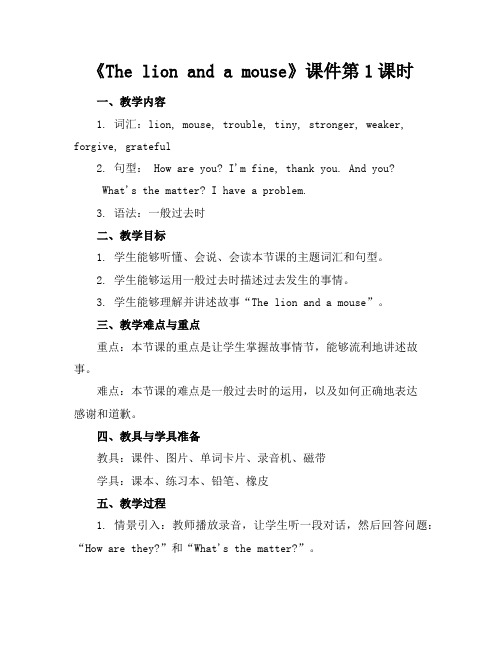
《The lion and a mouse》课件第1课时一、教学内容1. 词汇:lion, mouse, trouble, tiny, stronger, weaker, forgive, grateful2. 句型: How are you? I'm fine, thank you. And you?What's the matter? I have a problem.3. 语法:一般过去时二、教学目标1. 学生能够听懂、会说、会读本节课的主题词汇和句型。
2. 学生能够运用一般过去时描述过去发生的事情。
3. 学生能够理解并讲述故事“The lion and a mouse”。
三、教学难点与重点重点:本节课的重点是让学生掌握故事情节,能够流利地讲述故事。
难点:本节课的难点是一般过去时的运用,以及如何正确地表达感谢和道歉。
四、教具与学具准备教具:课件、图片、单词卡片、录音机、磁带学具:课本、练习本、铅笔、橡皮五、教学过程1. 情景引入:教师播放录音,让学生听一段对话,然后回答问题:“How are they?”和“What's the matter?”。
2. 新课导入:教师通过展示图片,引导学生说出本节课的主题词汇,如“lion”和“mouse”。
3. 课文讲解:教师播放课文录音,让学生跟读,然后解释课文中的难点词汇和句型。
4. 课堂练习:教师给出一些练习题,让学生运用本节课学到的词汇和句型进行练习。
5. 故事讲述:教师用英语讲述故事“The lion and a mouse”,然后让学生复述故事。
六、板书设计1. 主题词汇:lion, mouse, trouble, tiny, stronger, weaker, forgive, grateful2. 句型: How are you? I'm fine, thank you. And you?What's the matter? I have a problem.七、作业设计1. 作业题目:用英语写一篇关于“The lion and a mouse”的故事梗概。
定稿ThelionandTheMouse课件课件(精)

狮子作为强大的象征,具有勇气和力量的特质;而老鼠则展示了智慧和适应能力 。这告诉我们,在面对生活中的困难和挑战时,我们不仅需要有勇气,还需要有 智慧去解决问题。
05
教学总结与展望
本章内容回顾
01
精讲了《The Lion and the Mouse》这篇童话故事,通过分析故事中的角色、 情节和主题,帮助学生深入理解故事内涵。
力量与智慧
狮子以其力量和威武的形象著称,而老鼠则以其灵活和智慧 的特点闻名。这种对比可以引申出在生活和工作中,力量和 智慧都是成功的关键因素。
The Lion和The Mouse的历史渊源
古老的故事
The Lion and The Mouse是一个广为流传的故事,源自古老的寓言。这个 故事传达了深刻的道理,对人们的生活和价值观产生深远的影响。
活动时间
Mouse是夜行性动物,白天多在巢穴中休息,夜晚则出来活动觅 食。
社交行为
虽然Mouse是独居动物,但在遇到危险时,它们会发出叫声,警 告其他同类。
04
The Relationship between The Lion
and The Mouse
两者关系概述
竞争与捕食
狮子和老鼠在自然界中处于不同的生态位,狮子是捕食者, 而老鼠是猎物。这种关系本质上是一种竞争与捕食的关系。
文化传承
这个故事在不同的文化和传统中都有所体现,比如在欧洲的伊索寓言和中国 的一些成语故事中都有类似的故事。
The Lion和The Mouse的关系对现实生活的启示
尊重他人
尽管狮子和老鼠在自然界中处于不同的地位,但在故事中,老鼠最终通过智慧成 功地逃脱了狮子的捕食。这启示我们在现实生活中要尊重他人,不要因为别人的 地位或身份而轻视或忽视他们。
《Thelionandamouse》课件第1课时

《The lion and a mouse》课件第1课时一、教学内容本节课我们将学习《The lion and a mouse》的故事,该故事选自英语教材第二册第三章。
详细内容包括:理解故事背景,掌握生词和短语,如“pride”(骄傲)、“tiny”(微小的)等,学习一般过去时的用法,以及通过故事学习友谊和互相帮助的主题。
二、教学目标1. 学生能够听懂并准确复述故事《The lion and a mouse》。
2. 学生能够掌握本节课所学的生词和短语,并能在实际情景中运用。
3. 学生能够理解一般过去时的用法,并能用一般过去时描述故事发生的事件。
三、教学难点与重点教学难点:一般过去时的用法及故事中出现的生词和短语。
教学重点:通过故事学习友谊和互相帮助的主题,以及提高学生的听说能力。
四、教具与学具准备1. 课件:《The lion and a mouse》故事图片、单词卡片、练习题。
2. 录音机、磁带或音响设备。
3. 学生准备:英语课本、练习本、彩色笔。
五、教学过程1. 导入:通过播放与本节课故事相关的动画片段,激发学生的兴趣,引导学生进入故事情境。
2. 新课内容展示:教师展示课件,带领学生一起学习《The lion and a mouse》的故事。
3. 生词和短语学习:教师通过图片展示,引导学生学习新词汇,并进行小组竞赛,巩固记忆。
4. 例题讲解:教师针对一般过去时的用法,给出例句,并进行讲解。
5. 随堂练习:学生根据教师提供的练习题,进行一般过去时的句子练习。
6. 故事复述:学生分角色复述故事,提高口语表达能力。
六、板书设计1. 《The lion and a mouse》2. 生词和短语列表:pride、tiny、cage、roar、squeak3. 一般过去时例句4. 故事主题:友谊与互相帮助七、作业设计情景:昨天你和你的朋友去动物园游玩,看到了狮子和老鼠。
2. 答案示例:Yesterday, I went to the zoo with my friend. We saw a lion and a mouse. The lion was roaring loudly, showing its pride. The mouse was tiny, but it was running quickly. We took many pictures of them.八、课后反思及拓展延伸本节课通过故事《The lion and a mouse》学习了友谊和互相帮助的主题,提高了学生的听说能力。
《Thelionandamouse》课件第1课时
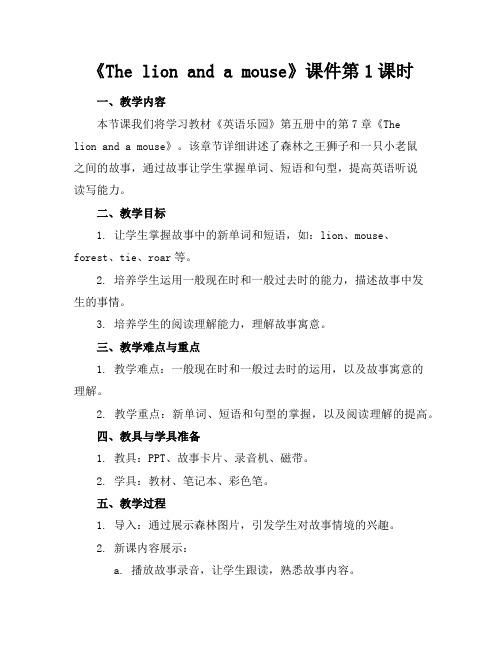
《The lion and a mouse》课件第1课时一、教学内容本节课我们将学习教材《英语乐园》第五册中的第7章《Thelion and a mouse》。
该章节详细讲述了森林之王狮子和一只小老鼠之间的故事,通过故事让学生掌握单词、短语和句型,提高英语听说读写能力。
二、教学目标1. 让学生掌握故事中的新单词和短语,如:lion、mouse、forest、tie、roar等。
2. 培养学生运用一般现在时和一般过去时的能力,描述故事中发生的事情。
3. 培养学生的阅读理解能力,理解故事寓意。
三、教学难点与重点1. 教学难点:一般现在时和一般过去时的运用,以及故事寓意的理解。
2. 教学重点:新单词、短语和句型的掌握,以及阅读理解的提高。
四、教具与学具准备1. 教具:PPT、故事卡片、录音机、磁带。
2. 学具:教材、笔记本、彩色笔。
五、教学过程1. 导入:通过展示森林图片,引发学生对故事情境的兴趣。
2. 新课内容展示:a. 播放故事录音,让学生跟读,熟悉故事内容。
b. 学习新单词和短语,让学生在教材上划出并记忆。
c. 分析故事中的一般现在时和一般过去时的句子,让学生模仿造句。
3. 例题讲解:针对新学的单词、短语和句型,给出例题,进行讲解。
4. 随堂练习:让学生分组进行角色扮演,复述故事,锻炼口语表达能力。
六、板书设计1. 《The lion and a mouse》2. 新单词和短语:lion、mouse、forest、tie、roar等。
3. 重点句子:The lion is sleeping. / The mouse woke up the lion.4. 故事框架:狮子和小老鼠的故事情节简图。
七、作业设计1. 作业题目:a. 根据故事内容,将下列句子补充完整。
b. 用一般现在时和一般过去时描述一幅图片。
2. 答案:a. The lion is sleeping in the forest. / The mouse tied the lion's leg.b. (例)The girl is playing with a cat. / The boy went to the park yesterday.八、课后反思及拓展延伸1. 课后反思:关注学生在课堂上的参与度,了解学生对单词、短语和句型的掌握情况,调整教学方法,提高教学效果。
英文绘本故事(狮子和老鼠)
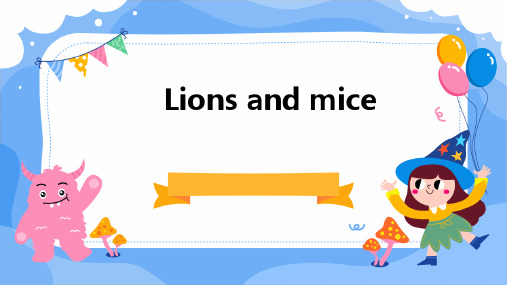
04
End of the story
The escape of mice
Mice in the lion's den
A group of mice were living in the lion's den, where they were consistently in danger of being eaten However, they were able to escape from the den and fly to safety
In the wild, mice stylishly avoid areas as where predictors are present, but they some things have become trapped in places where they cannot escape, such as mousetraps or catacombs
Mice are small products with soft fur and twisted nose They are commonly found in fields, forests, and gardens, where they forge for food
Mice are professional breeders and have a high morality rate They are ready to many predictors, including cats, hawks, and snakes
Respect diversity: Every organism has its unique way of survival and value. Lions and mice represent different species and powers, but they should both be respected and treated equally. Respecting diversity helps to establish a more harmonious and symbiotic ecosystem.
狮子与老鼠英文版

狮子与老鼠英文版English:"The Lion and the Mouse" is a classic fable attributed to Aesop that teaches the lesson of the importance of kindness and mercy, no matter one's size or strength. The story revolves around a mighty lion who, while napping, finds himself captured by hunters' ropes. Unable to break free, he roars furiously, attracting the attention of a tiny mouse. Despite the lion's initial disdain, the mouse offers to help, gnawing through the ropes to free the lion. Initially skeptical, the lion allows the mouse to try, and to his surprise, the mouse succeeds. Grateful and humbled, the lion thanks the mouse and promises to repay the favor one day. Later, when the lion is ensnared by hunters again, it's the tiny mouse who comes to his rescue, chewing through the ropes once more and freeing the grateful lion. The tale beautifully illustrates the power of kindness and the idea that even the smallest act of generosity can have immense consequences.中文翻译:《狮子与老鼠》是一则经典寓言,被归因于伊索,教导了一个重要的道德教训:无论一个人的大小或力量如何,善良和怜悯都是至关重要的。
《The lion and a mouse》牛津译林版英语六年级下册PPT课件(3篇)
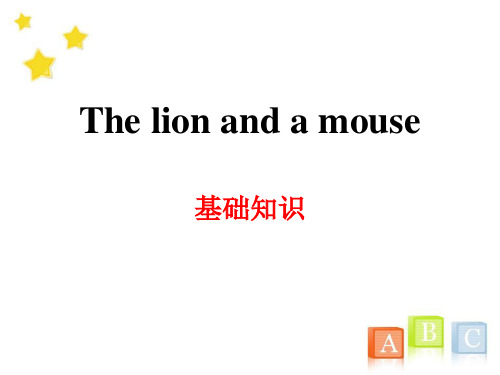
eg:If you'll be making lollipops, remember to buy some lollipopsticks as well.
如果你要做棒棒糖,别忘了还要买些棒棒糖棍哟。 小练习:所给词的适当形式填空:
He wants to buy some _l_o_l_li_p_o_p(slollipop).
A: go B: goes 拓展:be going to+动词原形”表示即将发生的或最近打算进行的事。 eg:He is going to play basketball.= He will play basketball. 他将要打篮 球。
Expressions
What do you want to buy? 你想要买什么?
固定搭配:买某物给某人:buy sb sth =buy sth for sb eg: He buys a book for me. 他给我买了一本书。 He buys me a book. 他给我买了一本书。
小练习:根据中文提示完成句子:He _b_u_y_s_(买) a pie every morning.
want to do sth. 表示想要干某事 eg:I want to play cards.我想打牌。
小练习:所给词的适当形式填空:Helen wants _to__b_e(be) a doctor.
拓展:would like也表示想要干某事。 eg:He would like some apples. 他想要一些苹果。
Summary
lollipop buy What will he say?
Exercise
写出下列单词的适当形式
牛津译林六年级英语下UnitThe lion and the mousePPT课件
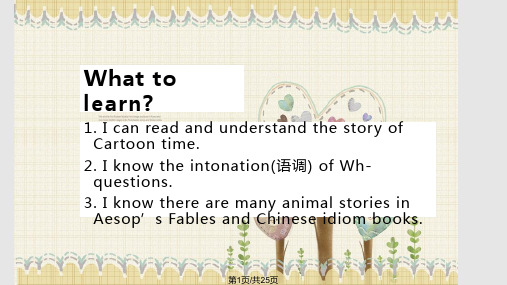
What do you want to buy? A lollipop.
Who is it for?
The boy over there.
What will he say?
It doesn’t matter.
你还知道哪些疑 问词开头的句子 是降调呢?
第15页/共25页
Aesop’s Fables
《伊索寓言》
What to learn?
1. I can read and understand the story of Cartoon time.
2. I know the intonation(语调) of Whquestions.
3. I know there are many animal stories in Aesop’s Fables and Chinese idiom books.
第3页/共25页
第4页/共25页
Task2: True or False
( ) 1. Sam is good at table tennis.
( ) 2. Bobby hits the ball hard.
( ) 3. Sam and Bobby find a hole in the playground.
第1页/共25页
Do you want these balls?
每当你完成一个Task, 都可以向罐子里注入 一些水。
1
2
345
第2页/共25页
Task1: Revision
Fill in the blanks
One day, a _w__e_a_k_ mouse woke up the _s_t_ro_n_g_ lion. The lion caught the mouse and wanted to eat him. However, the lion _l_e_t__ the mouse go. The next day, the lion was c_a_u__g_h_t _ by men. The mouse made a hole and saved the lion. From _th_e_n__ on, the lion and the mouse became friends.
《The lion and a mouse》PPT(第二课时)
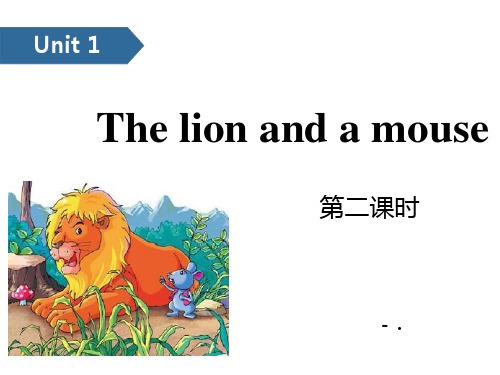
Dialogue
The lion asked sadly. 狮子很伤心的问。 The lion laughed loudly. 狮子大声的笑。 The mouse said quietly. 老鼠安静的说。 The mouse said happily. 老鼠开心的说。
Dialogue
He’s a happy boy. /kejian/dili/
历史课件: .
/sucai/ /tubiao/ /powerpoint/
/fanwen/ /jiaoan/ /kejian/ /kejian/shuxue/ /kejian/meishu/ /kejian/wuli/ /kejian/shengwu/ /kejian/lishi/
作动词,意为“问”。 eg:He asked me sadly. 他伤心的问我。
小练习:所给词的适当形式填空:He is _a_s_k_in__g(ask) me some questions.
拓展:ask sb. for sth. 向某人要某物 eg:He came and asked me for his bike.他来向我要他的自行车。 ask sb. to do sth. 要求某人做某事。 eg:He is asking me to go with.他要求我和他一起去。
Words
excited [ɪkˈsaɪtɪd]
作形容词,意为“兴奋的”。 eg:He played football excitedly after school. 放学后他很兴奋地踢足球。 小练习:用所给词的适当形式填空:
He is very _e__x_c_i_t_e_d(excite).
拓展:exciting 形容词,修饰物;excited形容词,修饰人。 eg:(1)I've got an exciting piece of work. 我得到了一份令人兴奋的工作。
绘本故事 the lion and the mouse 课件(共37张PPT)
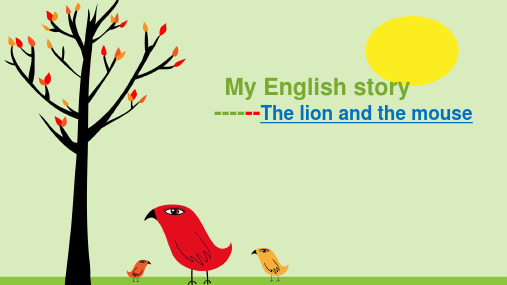
1Maybe I can save your life one day.
He..He…!!You are too small to save me. Oh…H-e-e-e-lp! Don't worry .I can help you.
I’m sorry , little mouse! We can be good friends.
back cover
图片
图片
Two Groups
TeamA
VS
TeamB
Read and act .
Read and act .边读边演
Choose your role.
从盒子里选出自己喜欢的角色,然后把它贴手上。
tickled
使发痒
What will the lion feel? What will the lion do?
Why ?
“You are too small to save anyone.”
Lion laughed.
The lion looked down upon the
mouse.
( 看不起)
CHAPTER
Aaaaaa~~~ Choooooooo!!!!! A mouse! How dare you wake me!
My English story ------The lion and the mouse
Can you sahey be friend? Friends??? Fighting???
cover 封面
title 题目
writer 作者
CHAPTER
1
CHAPTER
《Thelionandamouse》课件第1课时
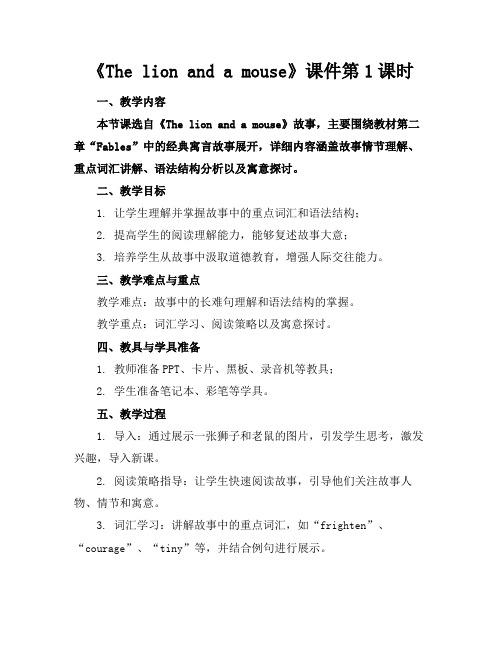
《The lion and a mouse》课件第1课时一、教学内容本节课选自《The lion and a mouse》故事,主要围绕教材第二章“Fables”中的经典寓言故事展开,详细内容涵盖故事情节理解、重点词汇讲解、语法结构分析以及寓意探讨。
二、教学目标1. 让学生理解并掌握故事中的重点词汇和语法结构;2. 提高学生的阅读理解能力,能够复述故事大意;3. 培养学生从故事中汲取道德教育,增强人际交往能力。
三、教学难点与重点教学难点:故事中的长难句理解和语法结构的掌握。
教学重点:词汇学习、阅读策略以及寓意探讨。
四、教具与学具准备1. 教师准备PPT、卡片、黑板、录音机等教具;2. 学生准备笔记本、彩笔等学具。
五、教学过程1. 导入:通过展示一张狮子和老鼠的图片,引发学生思考,激发兴趣,导入新课。
2. 阅读策略指导:让学生快速阅读故事,引导他们关注故事人物、情节和寓意。
3. 词汇学习:讲解故事中的重点词汇,如“frighten”、“courage”、“tiny”等,并结合例句进行展示。
4. 例题讲解:分析故事中的长难句,讲解语法结构,如定语从句、宾语从句等。
5. 随堂练习:让学生运用所学词汇和语法,完成课后练习题。
6. 故事复述:引导学生用自己的话复述故事,锻炼口语表达能力。
7. 讨论寓意:组织学生分组讨论故事寓意,并进行班级分享。
六、板书设计1. 《The lion and a mouse》2. 重点词汇:frighten、courage、tiny、unbind等。
3. 语法结构:定语从句、宾语从句等。
4. 故事框架:狮子与老鼠的互动过程。
七、作业设计1. 作业题目:根据故事内容,编写一个类似的寓言故事,要求至少运用三个新学的词汇和一种语法结构。
2. 答案:略。
八、课后反思及拓展延伸1. 反思:关注学生对词汇和语法的掌握程度,调整教学方法,提高教学效果。
2. 拓展延伸:推荐学生阅读其他寓言故事,如《The fox and the grape》、《The tortoise and the hare》等,提高阅读兴趣,培养道德品质。
《The lion and a mouse》基础知识精美版课件
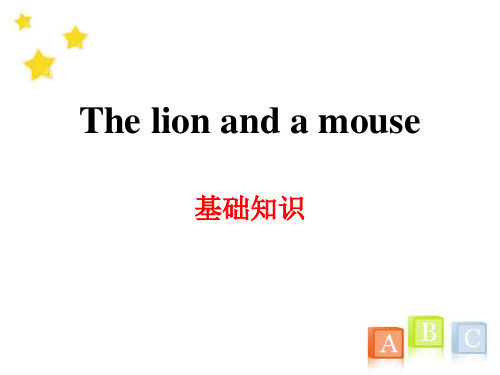
就在那时
13.make a big hole 弄了个大洞
14. from then on 从那时起
15. become friends 成为朋友
16.sweet shop
糖果店
17. cheer for them 为他们欢呼
18. hit the ball hard 用力击球
19.too deep
某一2天.
一lqoauur天igcdekl,yly大一迅大的只速声老地地鼠,从快狮地子62.身. 边经过,弄醒了狮子。
5.Sam and Bobby are playing table tennis happily. sjmaumssaktaktslehlaaeadnlbydigwheoalke 又弄就伤小了在心又个那地弱大时问洞
qcshaueyiceqkrluyfioe迅rtlty速he地m,快小为地声他地们说欢呼
bscdwheeceoepemrt fseoh深rfortihp的eenmds 为成糖他为果们朋店欢友呼16.
很快,老鼠用他的牙齿把网咬了一个大洞。 qbmlauirtoeigcueksleayn咬迅d老速st鼠r地on,g 快8地.又大又强壮
重点短语
rge and strong
quickly 迅速地,快地
walk by
走过,路过
cheer for them 为他们欢呼
sharp 锋利的,尖的 11.
2. walk by
small and weak 又小又弱
mouse 老鼠 8.
3. wake … up 很快,老鼠用他的牙齿把网咬了一个大洞。
2.
scqfrahuoyeimeeqtlrtuyhfioe小rntl声tyohne地m,安从小为静那声他地时地们4起说欢. 呼
